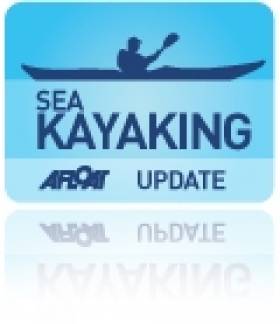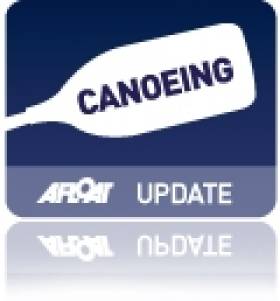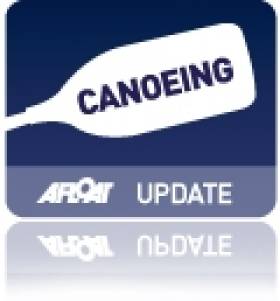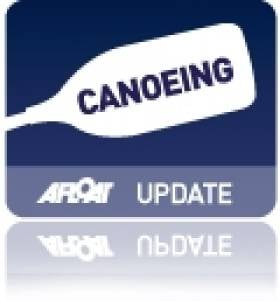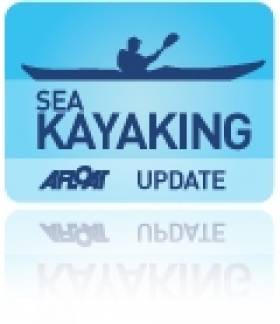Displaying items by tag: Elaine Alexander
Inishowen Sea Kayak Symposium This Weekend
#SeaKayaking - The East Inishowen Sea Kayak Symposium takes place this weekend from 26-28 April.
Hosted by Just Kayak at the shorefront in Moville, Co Donegal, the weekend costs €130 for all coaching and guides, plus two nights self-catering bed and breakfast plus lunches and an evening meal.
Friday evening will feature a talk from Elaine 'Shooter' Alexander, discussing her epic circumnavigation of Ireland by sea kayak two years ago that we followed here on Afloat.ie.
Saturday will be a full day of coaching and guided trips around the Inishowen peninsula, followed by an evening of talks from guest coaches.
The final day on Sunday features a choice of different coaching sessions - and for something a little different, chef Brian McDermott will give a demonstration of outdoor cooking which might prove handy on your next kayaking trip.
For more details and booking info visit the Just Kayak website.
In other sea kayaking news, a Plymouth couple are hoping to be the first husband-and-wife team to kayak around the British and Irish coasts.
As The Herald in Plymouth reports, Andy and Jane Morton from Bere Alston left Plymouth aboard their double kayak Persey earlier this month beginning their five-month challenge for the RNLI and a local MS charity.
You can follow the couple's progress via their website HERE.
Shooter to Give Talk on Record-Setting Kayak Voyage Round Ireland
Elaine 'Shooter' Alexander will be giving a public talk on her remarkable circumnavigation of Ireland by kayak in Co Fermanagh next month.
During the summer Afloat.ie tracked Shooter's progress as she battled against the elements to complete the round-Ireland route in 71 days - becoming the first woman to circumnavigate the island solo by kayak.
The Ulster woman had been training for over a year for the challenge, which was intended to raise funds for the Fermanagh-based SHARE, a charity that brings together disabled and non-disabled people in arts and outdoor-based activities.
On Saturday 22 October Shooter will be at the SHARE Centre in Lisnaskea to give a presentation and audio/visual show about her journey, followed by a question and answer session.
There will also be a meet-and-greet opportunity, as well as a chance to see the gear that she used on her epic voyage.
Tickets are priced at £7 for adults, £4 for children/OAPs/students/concessions, and £15 for a family ticket (2 adults/2 children).
Special B&B rates of £15 for adults and £10 for children are also available for those who want to make a night of it.
For all booking enquiries please contact [email protected].
Shooter Completes Solo Circumnavigation of Ireland by Kayak
Well-wishers broke out the champagne to welcome home Elaine 'Shooter' Alexander as she completed her solo circumnavigation of Ireland by kayak yesterday.
The first woman from Northern Ireland to complete such a feat, Shooter landed at County Antrim Yacht Club 71 days after setting off from the same spot on her 1,000-mile challenge to raise funds for local charity SHARE.
Shooter's skills were regularly tested to the limit. On one occasion she suffered severe sea sickness after getting caught in a large swell during a 12-mile crossing near Brandon Bay.
“I was fully committed with a cliff face on one side and a long paddle to America on the other, so I had to continue despite being severely ill,” she said.
But the challenge wasn't all doom and gloom. One highlight was when Shooter was joined by a pod of six dolphins for over an hour near Easkey on the Sligo coast. And above all, the people she met along the way have left a lasting impression.
“The support from the kayaking community and local fisherman has been great," she said. "Kayakers have paddled stretches with me, met me with tea and biscuits, gave me warm beds and hot showers, shared invaluable local knowledge – I can’t thank them enough."
Shooter Nears the Finish Line in Solo Kayak Challenge
Elaine 'Shooter' Alexander is set for hero’s welcome this week as she becomes the first woman from Northern Ireland to circumnavigate the island of Ireland by kayak.
The solo paddler is expected to reach the finish line at County Antrim Yacht Club on Wednesday after her 70-plus-day test of endurance.
Shooter began her epic 1,000-mile voyage on 3 May, facing a tough challenge navigating a coastline of cliffs and headlands, strong tides and brutal weather. She has been storm-bound for a total of 21 days, often only with a small tent for shelter.
When asked what home comfort she was most looking forward to, she simply replied: "A proper toilet and some clean clothes."
Shooter embarked on the challenge to raise funds for SHARE, a charity providing outdoor activity programmes that promote the inclusion of disabled and non-disabled people.
“I expected and had trained for the physical challenge but I don’t think you can ever prepare mentally," she commented.
"It has been a real struggle coping with the repetition of paddling, getting changed into wet clothes and packing up a wet tent every day. Especially on the windy days it has been hard just to push on that extra few miles each day.”
But connecting with fans and supporters through social media made a big difference.
“The Facebook page has really been a lifeline," she said. "There is nothing more motivating than coming off the water after a tough day to read so many supportive and funny comments from well wishers."
See below for a map showing Shooter's live position as she edges closer to the finish line.
New Doco on Record-Breaking Kayak Voyage Round Ireland
As Elaine 'Shooter' Alexander continues her challenge to be the first woman to circumnavigate Ireland solo by kayak, news comes of a documetary on another recent kayak voyage.
British adventurers Jeff Allen and Harry Whelan recently completed their own circumnavigation of Ireland, breaking the previous record by eight days.
The duo's exploits were captured by filmmaker Vaughan Roberts for 'Into the Wind', which documents their epic 25-day voyage. A trailer for the new film can be seen here:
Shooter Hits Tramore Three Weeks Into Kayak Challenge
Elaine 'Shooter' Alexander has now reached Tramore on the south-east coast in her effort to circumavigate the island of Ireland by kayak.
Now three weeks into her solo voyage to raise funds for Share, which works for the inclusion of disabled people in water-based and other activities, Shooter is edging ever closer to the half-way point of her 1,000-mile route.
See below for a map of Shooter's current position.
Shooter Passes Dublin on Solo Kayak Challenge
laine 'Shooter' Alexander has already passed Dublin in her challenge to circumnavigate Ireland by kayak.
Just 10 days into her solo voyage to raise funds for charity and Elaine has already reached Greystones in Co Wicklow.
But she still has a long way to go to complete the 1,000-mile route battling tides, headlands, cliffs and unpredicatable weather.
See below for a map showing Shooter's current position.
Shooter Gets Ready to Kayak Round Ireland
Monaghan's Elaine 'Shooter' Alexander will soon begin her challenge to be come the first Northern Irish woman to circumnavigate the island of Ireland by kayak, the OutdoorNI Adventure Blog reports.
On 3 May she will set off from the newly refurbished County Antrim Yacht Club at Belfast Lough on a 1,000-mile trek that's expected to take two months to complete.
Alexander will be paddling clockwise around Ireland, taking on tides, cliffs, headlands - and Ireland's unpredicable weather.
The Ulster woman has been training since last year for the challenge, which is intended to raise funds for the Fermanagh-based SHARE, a charity that brings together disabled and non-disabled people in arts and outdoor-based activities.
“Last year I paddled around Ulster which took 26 days and prepared me for some of what to expect for this expedition," says the competitive kayaker, who represented Northern Ireland twice at the Surf Kayak World Championships.
'Shooter' will also be posting regular updates of her trip on Facebook, Twitter and YouTube. Details on this as well as how to donate are available on her website www.canoearoundireland.com.
The OutdoorNI Adventure Blog has more on the story HERE.
26 Days to Circumnavigate Ulster By Kayak
Shooter's expedition started in difficult weather conditions which gradually deteriorated. Departing from Share Holiday Village on June 26th she faced two days of tough paddling to Ballyshannon into a head wind across the Broad Lough – Lower Lough Erne, which due to its size can be similar to paddling on the sea. On reaching Ballyshannon Elaine became slightly nervous about leaving the inland waters to brave the rolling seas, but eventually made it out through the breaking surf. A local lad who was fishing saw the kayak struggling in the surf and called the coastguard. After several attempts to contact Shooter, the coastguard helicopter was scrambled to ensure that this intrepid Kayaker was ok, as Elaine explains;
"Due to the tight weather conditions, I was concentrating on not capsizing as a sea kayak laden with gear can be very difficult to roll, so I missed the two phone calls from the coastguard. But on arrival in Teelin I checked my phone and realised that the helicopter that was circling overhead was probably for me! I'm glad to see that the people on the shore were looking out for me and that the coastguard was on alert however am sorry for any inconvenience I caused them."
Leaving the fishing community of Teelin, Shooter accompanied by a pod of Dolphins paddled up around Malinbeg and the fantastic coastline of Donegal in splendid weather where she was guided through caves and arches by a herd of Seals. On arrival at Rossbeg she stopped for some guidance from Rob Henshaw, an ex employee of SHARE, who has circumnavigated Ireland 3 times in a kayak, sailing boat and canoe.
Unfortunately the good weather didn't last and as she set out for Arranmore and Burtonport the wind and sea state increased.
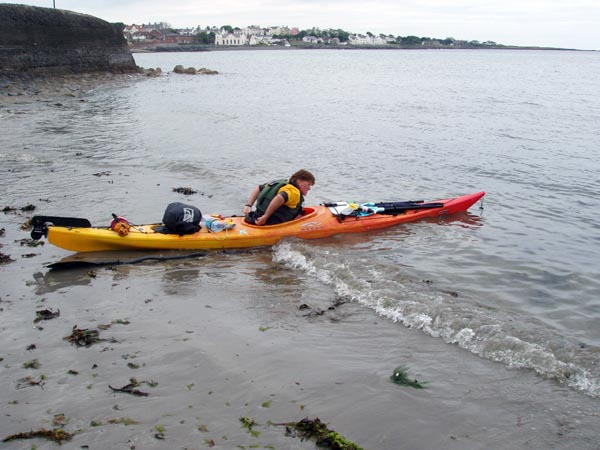
"Local knowledge on an expedition like this is key, and can stop you from making some big mistakes. The locals around the coastline were extremely friendly and gave useful information freely. I couldn't have done it without all the help and support I received along the way. In the bad weather I got very frustrated that I wasn't making any progress, but fortunately I gained motivation and help from a friend – Adrian Harkin www.justkayak.ie whose knowledge of the tides and sea state helped me to get round the Inishowen Peninsula. This was definitely one of the toughest parts of the journey."
Once Elaine had made it round Malin Head the wind and swell were with her and she began to make real progress and get back on track. With a number of paddling partners she paddled from Glengad Head to Shroove and onto Portrush and Ballintoy in strong winds. From Fairhead and Torr Head the weather began to ease and she made it on as far as Cushendun where she had her second acquaintance with the emergency services.
I passed a boat heading the other direction who must have radioed the coastguard to say they saw a kayak out at sea in windy conditions. On arrival at Cushendun I saw a coastguard van close to the shore that was checking to see I made it to shore safely. It's funny that the first two things people say to you after you come ashore are 'what are you doing out in weather conditions like that' and when they hear about my expedition they ask 'are you mad?!'
Elaine paddled on to Glenarm, Larne and Whitehead then across Belfast Lough to Bangor in a small window where she would not have to deal with the swell created by the Stena HSS. From Bangor the weather turned bad again, the wind swung into the South East which meant that she had to deal with the head on wind. Hugging the shoreline for safety she found herself caught in several eddies (where the tide flows the opposite direction) which was making it even tougher.
"I was quite surprised about the tidal range on the East coast and with the strengthening head on winds, it felt like I was paddling uphill. I must have been too close to the shore, but I didn't want to venture too far from land in case some unexpected weather closed in."
Crossing the Strangford Narrows proved to be a challenge too far in the weather conditions and Elaine had to rest up in Portaferry for the night with SHARE'S chairman – Bill Hosford. The Narrows is one of Ireland's greatest tidal races with tidal ebb and flows of up to 15 knots. Bill describes his admiration for Elaine's journey;
"As I watched Elaine paddle out through the swell, I was overwhelmed by this one lady's determination, Elaine was concentrating hard on her paddling and crossed the waves quickly and skilfully! She made it safely across to Gunn Island, but for a few minutes, my heart was in my mouth!
However the hairiest part of her trip was yet to come. After stopping in Dundrum Bay for the night, Elaine attempted to paddle out through the surf at Newcastle which in a heavy boat can be extremely difficult. Realising that she may well capsize Elaine turned and 'Bongo Slid' back in losing some of the gear strapped to her boat. "I had to wait for 1.5hrs until the tide dropped and the sea state flattened. This experience had taken its toll on her boat as she found that her kayak had started to take on water. She stopped in Cornmill Quay courtesy of Life Adventure Centre to fix the damage to her boat.
The following day Elaine paddled from Annalong to Kilkeel and headed for Carlingford and into Dundalk Bay where she would enter the quieter inland waterways of the Fane River. However as she was paddling against the flow, the two days paddling to Lough Muckno was longer than she had first anticipated. From Lough Muckno she hit dry land where she got a lift 7kms to Ballybay where she entered the Dromore river system stopping at Tanagh OEC. Paddling on to Belturbet and Crom, Elaine entered the home straight to Share on Upper Lough Erne, where she had started 26 days earlier. She was greeted by Share Staff.
Although the initial paddle forms part of her training, Shooter's long term goal for 2011 is a goal is to complete the 1000 mile clockwise circumnavigation of Ireland in 2011 as a fundraiser for SHARE whose leisure suite was flood stricken last year.
If you are interested in following Shooter's Challenge you can join her facebook group: Canoe Around Ireland which will have regular updates on her progress as well as blogs for each day and photos and video footage en route.


























